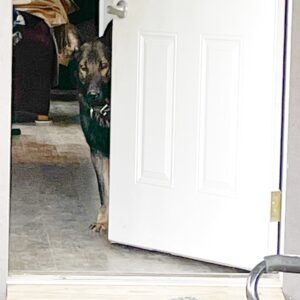Welcoming a dog into your life is to invite love, loyalty, and enthusiasm through your front door. However, ensuring that your canine companion also greets the world with decorum and manners is an essential part of responsible dog ownership. Training your dog to ‘wait’ before charging out any door, whether it’s the front gate or the car door, is not just about control — it’s about safety and developing a strong canine- human bond.
In this extensive guide, we’ll walk you through the process of training the “wait” command, and why it’s crucial for your dog’s well-being. We’ll explore the intricacies of canine behavior and provide a comprehensive roadmap for both teaching and reinforcing this invaluable cue. By the time you finish reading, you’ll be equipped with the tools to transform your dog’s door and feeding manners from chaotic to calm, one command at a time.
Table of Contents
Why Door Manners Matter
Safety First
Uncontrolled door dashes can lead to devastating results, including accidents, lost pets, or other unsafe situations. By instilling the ‘wait’ command, you can prevent your dog from bolting into potential danger and ensure a safe entry or exit each time.
Enhanced Bonding
Training your dog to wait is more than just a mechanical exercise. It’s a demonstration of your leadership and strengthens the trust and bond between you and your pet.
The “Wait” Command Demystified
In dog training, ‘wait’ means to pause and hold position, typically for a short time, until given a release command. It is different from ‘stay’, which requires a longer hold and can be variable in distance. The ‘wait’ command teaches your dog an immediate sense of control, which is especially useful when it comes to doors, gates, and other entryways.
The Core Principles
- Clarity: Your commands should be clear and consistent. Use the same word, the same tone, and the same body language every time.
- Timing: Your timing is crucial. You must issue the command at the point when your dog can understand it and before he starts his own process of heading through the door.
- Expectations: Set reasonable expectations and take baby steps. Your dog isn’t going to transform into a model door-greeter overnight.
- Motivation: Use positive reinforcement, rewards, and motivation to make the lesson stick. A willing student learns faster than one under duress.
Step-by-Step Guide to Teaching the “Wait” Command
Step 1: The Setup
Begin by attaching your dog’s leash before opening any door. This initial step will allow you to guide and control your dog as you begin training.
Step 2: The Command
Decide which cue you’ll use for ‘wait.’ It should be a simple, distinct word that you don’t use often in other contexts. “Wait” or “Hold” are clear choices.
Step 3: The Practice Drill
With your dog on the leash, command ‘wait’ as you approach the open door. If he begins to move, gently but firmly pull him back to his original position, repeating the word ‘wait’.
Step 4: The Release Command
Give a separate, clear release command like “okay” or “free” once your dog has waited patiently for a couple of seconds. This release lets your dog know that the wait period is over.
Step 5: Practice Patience
Develop patience yourself. Your attitude will be mirrored by your dog, so stay calm and consistent even if it takes longer for your dog to catch on.
Step 6: Gradual Increases
Extend the wait time slowly. Begin with just a few seconds and gradually increase it as your dog becomes more reliable.
Step 7: Generalization
Practice the ‘wait’ command at all doors that lead to outside, and then gradually introduce it inside the house, around different thresholds.
Step 8: Blessing Command
Introduce the ‘blessing’ command where leaving the door makes life better for your dog. For example, enter the backyard and give a treat, followed by a ‘blessing’ cue like “good outside” or “go play.”
Tips on Teaching Wait for Crate Door
Step 1 : With your dog in the crate, put your hand on the crate door and say “wait”
Step 2: Open the crate, but if your dog moves, close it in his face. You don’t need to repeat the command.
Step 3: Keep opening and closing the crate door until the dog puses and looks at you instead of rushing the door. Then say OK, let him out, and praise and treat effusively.
Tips to Teach Your Dog to Wait Before exiting the car
Step 1: Back tie your dog to the car head rest, opposite of the door you will be letting him out of.
Step 2: Put your hand on the door handle and say “wait”
Step 3: Open the door, and if your dog rushes to come out, close it in his face. No need to repeat the command.
Step 4: Keep doing this until the dog pauses and looks at you. Then say good boy and treat. He is back tied so he can’t come out so don’t say OK as that is your release word.
Step 5: Untie the back tie and in a safe place, practice all those steps again. until he waits for your OK to exit the car.
Practice both these wait exercises, opening the door, both slowly and suddenly, until no matter how you open the door, the dog waits for your OK before exiting.
Teaching You Dog to Wait for His Food Bowl
This one needs no command at all but you could use wait. Just let your dog see you filling his bowl with food. When you have his interest, take the bowl to where you feed him and begin to set it on the ground. If your dog has not been taught manners around this, he will probably rush you in his excitement. Simply stand back up with the bowl.
Your dog will do one of two things. He will either jump on you, in which case keep turning your back to him and say no. End the feeding if you have to and try again later. Alternatively, he will sit and look at you puzzled. Great!
Begin the exercise again. Bring the bowl towards the ground. If the dog gets up, just stand up again. Eventually, you will get the bowl on the ground. Your puzzled dog will be looking at you, waiting to see what you will do now. Say OK and let him eat.
Common Mistakes to Avoid
Inconsistent Cues
If ‘wait’ sometimes means stop for a second and other times means don’t move until I say, your dog will be confused and training will be ineffective. The goal should always be to wait for a release command, such as O.K. or free.
Lack of Patience
Training can be frustrating; a critical mistake is losing your cool. Dogs can sense frustration, and this will slow down their learning.
Overloading Commands
Don’t try and teach too many things at once. If you’re teaching wait by the door, it’s not the time to also work on sit, down, and shake.
Introducing Distractions
Wait under Temptation
Up the difficulty by introducing distractions like toys or the presence of another person or pet at the door. This will strengthen your dog’s ability to wait even when their enthusiasm is high.
Different Locations
Don’t limit training the ‘wait’ command to just one door or area in the house. Vary the locations to help your dog generalize the command and recognize it as a universal cue.
The Long-Term Benefits
Improved Obedience
A dog who waits at all doors is illustrating his acknowledgment of your authority and his self-command. This type of trainable obedience will serve you both in all areas of your cooperative life.
Safety Enhancement
Mastering the ‘wait’ command reduces the risk of your dog escaping into unsafe or uncontrolled areas. It’s a literal lifesaver in many situations.
Strengthened Bond
The trust and teamwork developed through training will create a stronger, more fulfilling bond between you and your dog. You’ll both enjoy a greater peace of mind in shared day-to-day activities.
Conclusion
Training a dog to wait at all doors is an investment in safety and a testament to the training efforts of a dedicated pet owner. It’s not always a smooth process, but the outcome is a well-behaved, safety-conscious companion who understands and obeys the boundaries you set. By following the steps outlined in this guide and being mindful of the common pitfalls, you’ll set you and your dog up for success.
Remember, the essence of any dog training is patience, love, and partnership. Stick to it, cherish the small victories, and don’t forget to celebrate every stage of progress with your furry friend. The open road of life is always safer when your loyal pup knows to ‘wait’ by your side.


